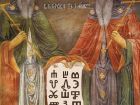The Mystery of the Bulgarian letters
The Mystery of the Bulgarian letters
Pointing out the “excellences” of the Slavonic script to the Greek alphabet, the Old-Bulgarian author Chernorizetz Hrabar claimed that if in Byzantium the creators of the Greek script were familiar to only few men-of-letters, in Bulgaria even school children knew that their letters had been conceived by Constantine-Cyril, the Philosopher.
Possibly, in the late 9th and early 10th century, i.e. the time when Chernorizetz Hrabar wrote his works, everything concerning the origin of the Slavonic script was absolutely clear. But now that in the course of already two centuries Slav scholars from all over the world have developed heaps of theories on this subject, the questions and mysteries in the field are often more numerous than the points known.
It is beyond dispute that the alphabet and the first translations of liturgical books to the Slavonic language were the work of Constantine-Cyril, the Philosopher (about 827-869). Paradoxically, however, within a short period of time two alphabets - the Glagolitic and the Cyrillic - were created and, respectively, replaced, and so far scholars are not unanimous in their opinion of which one of them was created by Constantine-Cyril.
The second one was the Cyrillic alphabet which is used in our days by Bulgarians, Serbs, Montenegrins, Russians, Ukrainians, Byelorussians, as well as by many non-Slavic peoples which belonged to the former Soviet Union. There is no doubt that both in its sounds and visual symbols it was based on the Greek uncial writing. It is assumed that this script was the work of Clement of Ohrid, one of Cyril’s disciples, who paid tribute to Cyril’s deed by naming the alphabet after him.
Most scholars give priority to the Glagolitic alphabet, referring to Constantine-Cyril as its author. This alphabet is known for its elaborate and exotic graphics. This is the reason why there exist a great number of hypotheses looking for its connection with different writing systems (ranging from the Slavonic runes through the Georgian script to ... Sanskrit).
It is a fact that no matter how different the Glagolitic and the Cyrillic alphabets may look, their continuity is obvious, which means that one comes from the other.
The Cyrillic alphabet displaced entirely and rapidly the Glagolitic alphabet in Eastern Bulgaria and in its first Christian capital - Preslav. In Western Bulgaria - the Ohrid region, the Glagolitic alphabet was more widely spread and long-lived. Along the Adriatic coast of Croatia it was current until the past century mainly in the form of cryptography in some monasteries.
The inscription of the Cyrillic and Glagolitic letters certainly did not remain unchanged in time. From the 9th century on, depending on the purpose of the text, different types of writing were developed - ustav, polu-ustav, the script of priest Gerasim, strongly influenced by the Greek minuscule, shorthand.
The layout of the manuscripts was also improved. Influenced by the decorative elements in the Byzantine manuscripts and modifying the designs in the Slavonic books, in the 13-14th centuries three styles were established in the illumination of headpieces - decorative compositions preceding the text blocks; of ornamented initial letters; of colophons - ornamental tailpieces shaping the end of the text. The illustrative cycles in the royal codices appeared - the Tomic Psalter of 1360, the London Gospel of 1356, the Chronicle of Manasses, 1344-45, the Munich Serbian Psalter of the late 14th century, the Kievan Psalter of 1397. Titlepieces developed in separate decorative compositions by means of letter ornamentation and colouring in red, blue and green, or in gold.





